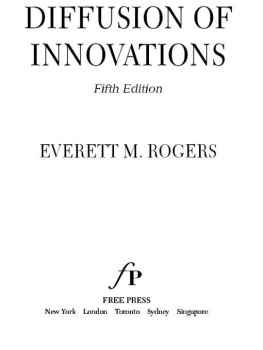Richard Ghez - Diffusion Phenomena: Cases and Studies
Here you can read online Richard Ghez - Diffusion Phenomena: Cases and Studies full text of the book (entire story) in english for free. Download pdf and epub, get meaning, cover and reviews about this ebook. year: 2018, publisher: Dover Publications, Inc., genre: Children. Description of the work, (preface) as well as reviews are available. Best literature library LitArk.com created for fans of good reading and offers a wide selection of genres:
Romance novel
Science fiction
Adventure
Detective
Science
History
Home and family
Prose
Art
Politics
Computer
Non-fiction
Religion
Business
Children
Humor
Choose a favorite category and find really read worthwhile books. Enjoy immersion in the world of imagination, feel the emotions of the characters or learn something new for yourself, make an fascinating discovery.
- Book:Diffusion Phenomena: Cases and Studies
- Author:
- Publisher:Dover Publications, Inc.
- Genre:
- Year:2018
- Rating:4 / 5
- Favourites:Add to favourites
- Your mark:
- 80
- 1
- 2
- 3
- 4
- 5
Diffusion Phenomena: Cases and Studies: summary, description and annotation
We offer to read an annotation, description, summary or preface (depends on what the author of the book "Diffusion Phenomena: Cases and Studies" wrote himself). If you haven't found the necessary information about the book — write in the comments, we will try to find it.
Diffusion Phenomena: Cases and Studies — read online for free the complete book (whole text) full work
Below is the text of the book, divided by pages. System saving the place of the last page read, allows you to conveniently read the book "Diffusion Phenomena: Cases and Studies" online for free, without having to search again every time where you left off. Put a bookmark, and you can go to the page where you finished reading at any time.
Font size:
Interval:
Bookmark:
Phenomena

Reprinted by permission from Chas Addams.
Phenomena
Copyright
Copyright 2001, 2018 by Richard Ghez
All rights reserved.
Bibliographical Note
This Dover edition, first published in 2018, is a corrected republication of the work originally published by the Kluwer Academic/Plenum Publishers. New York, in 2001.
International Standard Book Number
ISBN-13: 978-0-486-82832-9
ISBN-10: 0-486-82832-8
Manufactured in the United States by LSC Communications
82832801 2018
www.doverpublications.com
A Margalit qui,
tout en ne sachant pas la Mathmatique,
ne cesse de croquer la Pomme.
This book is a second edition of the one that was published by John Wiley & Sons in 1988. It carries a new title because the former one, A Primer of Diffusion Problems, gave the impression of consisting merely of a set of problems relating to diffusion. Nonetheless, my intention was clearly spelled out and it remains the same, namely, to teach basic aspects and methods of solution for diffusion phenomena through physical examples. Again, I emphasize that the coverage is not encyclopedic. There exist already several outstanding works of that nature, for example, J. Philiberts Atom Movements, Diffusion and Mass Transport in Solids. My emphasis is on modeling and methodology. This book should thus constitute a consistent introduction to diffusion phenomena, whatever their origin or further application.
This edition has been largely revised. It contains a completely new chapter and three new appendices. I have added several new exercises stemming from my experience in teaching this material over the last 15 years. I hope that they will be instructive to the reader for they were not chosen perfunctorily. Although they are the bane of authors and of readers, I have retained footnotes if they might help the readers comprehension. Additional, but nonessential material is collected at the end of chapters, and is indicated in the text by superscripts.
A few words are in order to explain why I have added a new chapter, the sixth, on surface rate limitations. By its very nature, diffusion is multidisciplinary; it is also multidimensional. All real physical systems have boundaries, and these are always dominant when the system is small. I had long felt that an introduction to the influence of boundaries beyond abstract mathematical statements for the resolution of specific problems was lacking in most texts on diffusion theory. I can but hope that this additional chapter will help the reader in this regard.
It was my pleasure to have worked with Evelyn Grossberg, editor for Kluwer Academic/Plenum Publishers, whose editorial remarks I gladly accepted.
Jerusalem
April 2001
Most kinetic processes in ponderable media require the redistribution of mass, energy, momentum, or charge over macroscopic distances. This redistribution occurs through a random process called diffusion, and its macroscopic description rests on a particular differential equation called the diffusion equation. Because this equation is to ponderable media what the wave equation is to vacuum, it is no wonder that its solutions should be relevant to widely different problems: from the heat treatment of alloys to the motion of proteins in growing axon membranes; from the dynamics of galactic structures to the multitude of device-processing steps. Consequently, the literature on diffusion contains at least four different points of view: as a mathematical topic in partial differential equations, as a physicochemical topic in nonequilibrium thermodynamics, as an engineering topic in materials science, and as a topic in stochastic processes. It would be presumptuous to claim familiarity with all these areas and to suggest, here, an equal coverage. And yet, they all derive from the same basic principle, namely, that something or other is conserved or can be balanced. Conservation is not so much an expression of longevity as in this person is well preserved but rather it expresses our ability to distinguish and to reckon. Nowhere, to my knowledge, is this point of view better illustrated than in the frontispiece, and I am deeply indebted to Mr. Chas Addams for his permission to reproduce an example of his always penetrating wit.
In spite of this formal unity of diffusion problems, it is my experience that many scientists and engineers remain baffled by the diffusion equation and by its solution in practical cases. Alternatively, they are perhaps trapped between purely mathematical texts and others that deal exclusively with diffusion mechanisms. This book seeks to bridge the gap between physicochemical statements of certain kinetic processes and their reduction to diffusion problems. It also attempts to introduce the reader to the many lines of attack, both analytic and numerical, on the diffusion equation. I have chosen to teach through physically significant examples taken mainly from my experience in the areas of metallurgy and semiconductor technology. The theory is interwoven, I hope, with sufficient rigor so that the tools that evolve do not immediately crumble with use. Nevertheless, I have chosen to write an introductory text, whose only prerequisites are a serious year of calculus, through ordinary differential equations, one semester of thermodynamics, and, if the reader be uneasy with algebraic manipulations, that the fear of calculating be controllable.
As its title implies, this is largely a book about solving the diffusion equation. I also wanted a short and lively text. Consequently, unless they provide particular insight, intermediate steps of specific calculations are often only verbally (though completely) expressed. In other words, the beginner would be well advised to arm himself with pad and pencil. Exercises, not so numerous as to paralyze the reader, are sprinkled throughout the text. They are designed either to emphasize a point that has just been made or to suggest some further clarification or extension of that point. These exercises are an integral part of the text, and (a word of encouragement) none is so difficult as to constitute a doctoral thesis.
The text consists of seven chapters and three appendices. These appendices contain more advanced material, whose inclusion within chapters would have detracted from the general flow. References, cited in the text are listed at the end of each chapter, and, in general, equations are numbered decimally within each chapter. I have sometimes labeled equations with an additional Latin letter when they are closely related. It can happen, therefore, that well ordering is not everywhere preserved.
I might be faulted on at least one count. My choice of topics is definitely biased, and each specialist will surely be disappointed to find that his particular area of expertise was not covered. This is unavoidable in so short a text, and I will simply observe that presentations of methodology and techniques are useful even though they fail as encyclopedias.
If any text is a slice of the authors life, it is also an image of his relations with others from whom he has benefited. I am grateful to my employer, the IBM Corporation, for allowing me the time and the use of its facilities to complete this book. Moreover, my experience with diffusion would be insignificant were it not for discussions and collaboration with many colleagues in this and other laboratories. Among these, I wish to single out my friends E. A. Giess, M. B. Small, F. M. dHeurle, T.-S. Kuan, all at IBM, and A. S. Jordan and G. H. Gilmer at AT&, Bell Laboratories. J. S. Lew and L. Kristianson, also at IBM, are gratefully thanked for their kindness and patience with my many queries. They are holders of increasingly rare skills (mathematical analysis and technical illustration) in a world that too often confuses quality with touch typing. I am also deeply indebted to Bea Shube and to her staff at John Wiley &Sons for their encouragement and help, particularly during those dark periods that every author knows. Finally, I wish to recall the memory of M. M. Faktor (Queen Mary College, London), a true and courageous friend and scientist.
Font size:
Interval:
Bookmark:
Similar books «Diffusion Phenomena: Cases and Studies»
Look at similar books to Diffusion Phenomena: Cases and Studies. We have selected literature similar in name and meaning in the hope of providing readers with more options to find new, interesting, not yet read works.
Discussion, reviews of the book Diffusion Phenomena: Cases and Studies and just readers' own opinions. Leave your comments, write what you think about the work, its meaning or the main characters. Specify what exactly you liked and what you didn't like, and why you think so.










